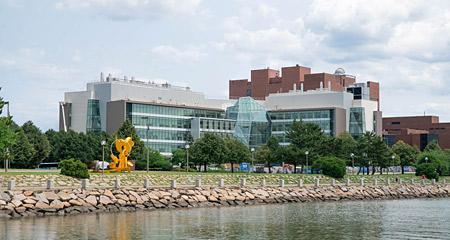October 23, 2014

The new Integrated Science Complex at UMass Boston will open for classes in the spring. Photo courtesy UMass Boston
Gov. Deval Patrick will be checking out the newest academic building to rise on the Dorchester campus of UMass Boston today as one stop on a whirlwind trip across the commonwealth to visit higher education institutions that have benefited from his administration.
The UMass building is being paid for in part by $125 million from the higher education bond bill signed by the governor in 2008.
The vast and glittering Integrated Science Complex at the Morrissey Boulevard entrance to Columbia Point, which is aimed at bringing the school’s cutting-edge research to the forefront, offers a stark contrast to the solemn, insular brick structures that defined UMass Boston’s early days in Dorchester.
Researchers, professors, and some staff will begin to populate the building’s office spaces in late November and students will be welcomed in for the opening of the spring 2015 semester.
The complex is the first of a number of buildings in line for development over the next 25 years at the city’s only public university. The second is General Academic Building Number One, which is scheduled to open next fall.
“The [complex] design was very intentional,” said Susan Wolfson, director of master planning. “This is a research lab building but it’s also about providing for the greater campus community. We want to encourage cross collaboration and this space helps foster that.”
Visitors enter the $182 million, 220,000 square-foot building through what is called the “crystal,” an aptly named central space five stories high with floor-to-ceiling windows and large glass panels expanding out from the building’s core in a crystal-like formation. While standing on any floor, visitors can see at least two other floors, giving the entire area an open, airy feel. Each floor is equipped with nooks with couches and white boards for small study groups that are available to students as well as to scientists and researchers.
“We listened to what students had to say and many said they wanted a space to gather and work collaboratively,” said Wolfson. The crystal will also have a cafe serving coffee and baked goods.
The design speaks to the building’s natural surroundings. Light fixtures throughout the crystal’s five floors are curved and clustered to look like schools of fish, a nod to the nearby bay. Outside the crystal’s doors is a botanical garden and amphitheater, which can be used for classes or as a gathering place. A nature walk lets visitors amble through native plants and vegetation.
“Back when the science buildings were built, in the ‘70s, nobody went outside,” says DeWayne Lehman, UMass Boston’s Director of Communications. “And planners didn’t take advantage of the natural beauty. This building was a real conscious decision not to do that again.”
Indeed, the new center is leaps and bounds ahead of the old brick science buildings. For starters, the entire building is bathed in natural light, with large windows in nearly every room and walkway, with labs separated by glass panels that allow light to spill into labs normally devoid of sunlight. Biologists on the third floor can catch glimpses of boats out in Boston Harbor while conducting experiments, and study stations for graduate students line the windows, perhaps making long hours spent poring over textbooks a bit more enjoyable, if a little distracting because of the view.
“You’re more productive in a good environment,” said Wolfson.
The building was designed by Boston-based architectural firm Goody Clancy and constructed by Walsh Brothers using union labor. Forty-eight percent of the laborers on the building were Boston residents, thirty percent of whom were from Dorchester, Lehman said.
UMass hopes the resulting productivity will be a boon. The building’s more than 80 labs will primarily serve graduate and PhD students in all scientific disciplines: biology, chemistry, environmental sciences, physics, and psychology as well as two new research centers, the Center for Personalized Cancer Therapy and the Developmental Sciences Research Center.
Undergrads will also have a stake in the building, with an introductory biology teaching lab and a so-called “sandbox lab,” which will allowing undergraduates to complete projects in state of the art facilities normally out of their reach.
The complex also earned a silver certification for its energy efficiency from the US Green Building Council’s Leadership in Energy and Environmental Design (LEED). The building is being funded by the higher education bond bill, the UMass Buildin


